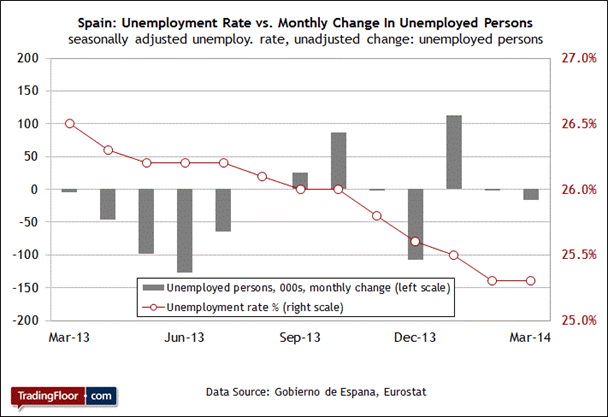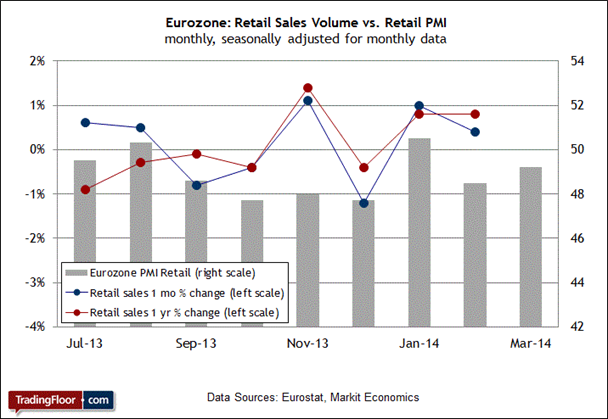Several economic updates for Europe arrive today, offering the potential for adjusting expectations for Thursday’s monetary announcement from the European Central Bank. First up: Spain releases new unemployment figures. Later, we’ll see updates on Eurozone retail sales and the trade balance for the US. Keep in mind that revisions are also scheduled for purchasing managers indexes (PMI) throughout Europe, including the Eurozone Composite PMI (08:00 GMT).
Spain Unemployment (07:00 GMT): The prospects for growth in the Eurozone are still modestly positive overall, but an optimistic outlook still comes with plenty of baggage these days. The ongoing run of deflation in industrial prices is one reason: the producer price index fell 1.6 percent for the year through March, Eurostat reported yesterday. That’s a slightly slower rate of decline compared to the previous month, but it’s a reminder that Europe’s weak recovery endures a precarious existence.
Spanish unemployment remains burdensome but is trickling downwards. Photo: Thinkstock
One of the genuine bright spots is Spain, at least in relative terms vs. the recent past. Although Europe’s fourth-largest economy is still struggling, the macro tide has made a directional change for the better in recent months. Hanging on to that change is critical, of course, for both Spain and Europe generally and so today’s update on the state unemployment for the country deserves close attention.
The good news is that the mildly positive trend remains intact, or so recent data suggests. Markit Economics last week reported that the country’s manufacturing sector posted “solid growth” in April via the Spain Manufacturing PMI. Employment growth in the sector, however, was slight. Meantime, after a mixed run of monthly jobless data late last year into early 2014, the number of registered unemployed workers in Spain fell in March for the second month in a row, and by a bit more than February’s tepid decline, according to government figures. The unemployment rate remains painfully high, at more than 25 percent through March, but it’s been trending down over the past year, albeit slowly and unevenly. If recent economic reports are an indication, however, today’s update will show more progress in paring the ranks of the newly unemployed.
Big-picture momentum is certainly helping. The Bank of Spain, in its April economic summary, estimated that economic growth picked up to a 0.4 percent quarterly rate from 0.2 percent in last year’s fourth quarter. Q1’s rise is the fastest in six years, but it’s still a weak pace for growth and so any improvement in the labour market will be modest until a faster expansion kicks in.

EU Retail Sales (09:00 GMT): Today’s report on retail spending is the last major economic number for the Eurozone ahead of Thursday’s policy statement from the European Central Bank (ECB). For the moment, the crowd’s expecting that the ECB will forgo a cut in interest rates, in part because inflation picked up a bit in the latest release. Consumer prices rose 0.7 percent for the year through March, according to Eurostat’s flash estimate. That’s slightly faster than February’s 0.5 percent pace. The uptick gives the bank more leeway to argue that deflation risk isn’t accelerating.
Although 0.7 percent inflation is still far below the ECB’s two percent target, many analysts say that the bank will wait to cut rates or launch a new program of monetary stimulus while consumer prices are stable or rising. But the outlook could become tricky if today’s retail data shows betrays more weakness.
As usual, we already have most of the retail numbers for the major economies for anticipating the overall March data for the Eurozone. Looking at the monthly comparisons via Eurostat, the profile is mixed, with Germany and Spain posting declines while France enjoyed a robust 2.3 percent increase in retail sales in real terms. The year-over-year trend through March is generally upbeat, however, with Germany and France reporting increases while Spain suffered another decline.
Not surprisingly, the consensus forecast sees a mixed picture for today’s Eurozone data: a 0.2 percent monthly decline that’s coupled with a stronger annual gain of 1.4 percent vs. 0.8 percent in the previous month. Nonetheless, confidence on the outlook for consumer spending is wobbly. The Eurozone Retail PMI has remained under the neutral 50 mark in both February and March. In fact, only January’s PMI number reflected growth in the last seven reports.
“The retail sector remains an area of relative weakness in the Eurozone economy, lagging behind the manufacturing and service sectors which have long been in growth phases,” a Markit economist said with the April report. “That said, the retail data suggest that the worst may have passed, with trade stabilising in France in line with positive trends elsewhere in the economy and Italian companies recording a much slower rate of decline.”
If so, we should see some of the evidence in today’s report. Disappointing numbers, by contrast, may renew calls on the ECB to do more than sit quietly and wait for better data.

US Trade Balance (12:30 GMT): First-quarter GDP was surprisingly weak for the US, with a near-flat performance of only 0.1 percent (seasonally adjusted annual rate). That’s the second-slowest quarter since 2009. Most economists think the sluggish first quarter was a victim of winter weather, and so growth will accelerate in Q2. Still, the sight of a sharp slowdown was disturbing to many eyes. One of the soft spots in Q1: exports, which tumbled 7.6 percent (on a seasonally-adjusted annual basis)—the biggest quarterly setback since the Great Recession ended five years ago. One of the reasons why economists think the news for US exports will improve: forecasts of stronger growth for Europe, which is a key market for US goods and services. The European Commission’s new spring forecast “points to a continuing economic recovery in the European Union following its emergence from recession one year ago.” The EC predicts growth of 1.2 percent for the Eurozone this year, up from a mere 0.1 percent in 2013. Next year is expected to do even better, we’re told, with a GDP rise of two percent in 2015.
That’s good news for US exports, assuming the forecast for Europe holds up. Today’s March trade report from Washington is expected to show some marginal improvement on that front. The consensus forecast calls for a slight retreat in the red ink: a trade deficit of USD 40.5 billion at the end of the first quarter, or modestly smaller than February’s USD 42.3 billion.
If the European Commission’s forecast is accurate, the US trade gap is probably on track to narrow further in the months ahead. That view would be a questionable prediction if the US was still importing growing quantities of crude oil. But here too the outlook is favourable for America. The boom in shale drilling has boosted domestic production in recent years, easing the US appetite for energy imports. “Over the last four weeks, crude oil imports averaged over 7.7 million barrels per day, 0.1 percent below the same four-week period last year,” the Energy Information Administration reported last week.

